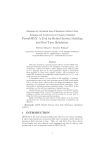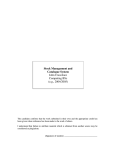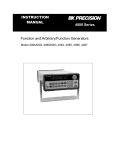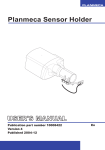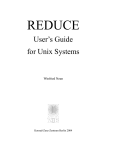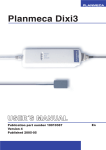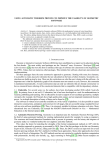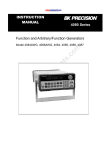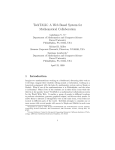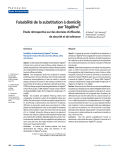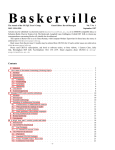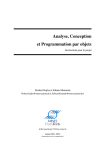Download ICM-199805-0003 - Kent State University
Transcript
Wei Wu, M.S., May, 1998
EXPERIMENTS
WITH
COMPUTER SCIENCE
INTERNET
ACCESSIBLE
MATHEMATICAL
COMPUTATION (55 pp.)
Director of Thesis: Dr. Paul S. Wang
The goal of Internet Accessible Mathematical Computation (IAMC) research is
to design a system to let the user access remote mathematical computation systems
based on the Internet through any computer platform machine, and to let the user do
numeric, symbolic, and other scientic computations. Internet users can input their
mathematical request, send it to the remote mathematical computation server, and
get the answer back.
The work here constitutes a simple proof-of-concept system where a simple IAMC
client-server pair is written in Java, MP is used for mathematical data encoding
and transfer, and the pair provides Internet-based access to the MAXIMA symbolic
computation system. By this experiment, we hope to shed more light on the IAMC
approach and to provide experience for a full-blown IAMC prototype.
EXPERIMENTS WITH INTERNET ACCESSIBLE MATHEMATICAL
COMPUTATION
A thesis submitted
to Kent State University in
partial fulllment of the requirements
for the degree of Master of Science
by
Wei Wu
May, 1998
Thesis written by
Wei Wu
M.S., Kent State University, 1998
Approved by
, Advisor
, Chair, Department of Mathematics
and Computer Science
, Dean, College of Arts and Sciences
ii
TABLE OF CONTENTS
LIST OF FIGURES
: : : : : : : : : : : : : : : : : : : : : : : : : : : : : : : :
v
LIST OF TABLES
: : : : : : : : : : : : : : : : : : : : : : : : : : : : : : : : :
vi
Acknowledgements
: : : : : : : : : : : : : : : : : : : : : : : : : : : : : : : : :
vii
: : : : : : : : : : : : : : : : : : : : : : : : : : : : : : : : : : :
1
1 Introduction
1.1 Motivation
: : : : : : : : : : : : : : : : : : : : : : : : : : : : : : : : :
1.2 Previous Work
1.3 IAMC
1
: : : : : : : : : : : : : : : : : : : : : : : : : : : : : :
2
: : : : : : : : : : : : : : : : : : : : : : : : : : : : : : : : : : :
7
2 Design of IAMC
: : : : : : : : : : : : : : : : : : : : : : : : : : : : : : : : :
2.1 Overview of IAMC System
10
: : : : : : : : : : : : : : : : : : : : : : : :
10
2.2 IAMC Client
: : : : : : : : : : : : : : : : : : : : : : : : : : : : : : :
14
2.3 IAMC Server
: : : : : : : : : : : : : : : : : : : : : : : : : : : : : : :
16
2.4 Object-Oriented Design
: : : : : : : : : : : : : : : : : : : : : : : : : :
17
3 IAMC Client
: : : : : : : : : : : : : : : : : : : : : : : : : : : : : : : : : :
21
3.1 Parsing
: : : : : : : : : : : : : : : : : : : : : : : : : : : : : : : : : : :
21
3.1.1 Inx Input
: : : : : : : : : : : : : : : : : : : : : : : : : : : : :
3.1.2 Recursive Descent Parsing
: : : : : : : : : : : : : : : : : : : :
3.1.3 IAMC Math-Expression Grammar
3.1.4 Tokens
21
23
: : : : : : : : : : : : : : : :
26
: : : : : : : : : : : : : : : : : : : : : : : : : : : : : : :
28
iii
3.1.5 Internal Representation
: : : : : : : : : : : : : : : : : : : : : :
3.1.6 Prex Notation Generation
3.2 ASCII{MP Conversions
: : : : : : : : : : : : : : : : : : :
29
: : : : : : : : : : : : : : : : : : : : : : : : :
32
3.2.1 Prex to MP Conversion
: : : : : : : : : : : : : : : : : : : : :
3.2.2 MP to ASCII Conversions
32
: : : : : : : : : : : : : : : : : : : :
33
: : : : : : : : : : : : : : : : : : : : : : : : :
33
: : : : : : : : : : : : : : : : : : : : : : : : : : : : : : : : : :
35
3.3 Interface to IAMC Server
4 IAMC Server
28
4.1 Interface to IAMC Client
4.2 The Compute Engine
: : : : : : : : : : : : : : : : : : : : : : : : :
35
: : : : : : : : : : : : : : : : : : : : : : : : : : :
36
4.3 Interface to Compute Engine
: : : : : : : : : : : : : : : : : : : : : : :
37
: : : : : : : : : : : : : : : : : : : : : :
40
: : : : : : : : : : : : : : : : : : : : : : : : : : : : :
44
5.1 Example 1
: : : : : : : : : : : : : : : : : : : : : : : : : : : : : : : : :
44
5.2 Example 2
: : : : : : : : : : : : : : : : : : : : : : : : : : : : : : : : :
45
5.3 Example 3
: : : : : : : : : : : : : : : : : : : : : : : : : : : : : : : : :
46
5.4 Example 4
: : : : : : : : : : : : : : : : : : : : : : : : : : : : : : : : :
47
: : : : : : : : : : : : : : : : : : : : : : : : : : : : : : : : : : : :
51
4.4 Server-Client Communication
5 IAMC Usage Examples
6 Conclusion
BIBLIOGRAPHY
: : : : : : : : : : : : : : : : : : : : : : : : : : : : : : : : :
iv
53
LIST OF FIGURES
1
Structure of IAMC
2
Programming Contributions
3
Flow of Computation Request
4
IAMC Classes
5
Example of Prex Generating
6
Java Exec Method
7
Interface to Compute Engine
: : : : : : : : : : : : : : : : : : : : : : : : : : : :
: : : : : : : : : : : : : : : : : : : : : : :
11
12
: : : : : : : : : : : : : : : : : : : : : :
19
: : : : : : : : : : : : : : : : : : : : : : : : : : : : : : :
20
: : : : : : : : : : : : : : : : : : : : : :
31
: : : : : : : : : : : : : : : : : : : : : : : : : : : :
32
: : : : : : : : : : : : : : : : : : : : : : :
v
43
LIST OF TABLES
1
IAMC Supported Operators
: : : : : : : : : : : : : : : : : : : : : : :
vi
22
Acknowledgements
I would especially like to thank my advisor, Dr. Paul Wang, for his direction,
advice, and guidance on this research. I would also like to thank Dr. Robert Walker
and Dr. Hassan Peyravi for their suggestion and comments on this project. Also I
would like to thank Benjamin Norman for his help on editing my thesis.
vii
CHAPTER 1
Introduction
1.1 Motivation
The Internet [9] is the network that is changing the way people communicate,
interact, and dene community. The Internet has a spirit of invention within the
human community it encompasses as expressed in the tools, software, and hardware
that are used. The Internet represents a changing paradigm for human interaction.
It is a collaborative medium in which you can access information and data; it is a
place for learning, commerce, entertainment, and intensive interaction with people.
A major purpose of the Internet is the sharing of information between universities, companies, governments, nonprot organizations, and individuals. At present,
millions of pieces of information are available on the Internet in a variety of formats,
but sharing of mathematical computation and data is lagging behind.
Some universities and organizations have mathematical computation systems, experimental and commercial, which are powerful tools for scientists, engineers, and
educators. They aim to automate mathematical computations of all sorts. These
tools may be general purpose such as Maple [21], MAXIMA [12], and Mathematica
[32] for computer algebra or specialized such as Camal [39] for general relativity and
Singular [40] for commutative algebra and algebraic geometry. On the other hand,
almost all the powerful computation systems are only accessible directly on their host
computers. Usually, outside users can not use these systems remotely without obtaining accounts on these machines and logging in rst. It is desirable to make powerful
1
2
mathematical and scientic computing systems accessible on the Internet as simply
and easily as a Web page.
Some simple tools, such as interactive calculators [38], exist on the Internet for
limited mathematical calculation, but a systematic approach for access, control, expression encoding, and interoperability must be devised if complex mathematicaloriented computation services are to become usable on the Internet via the clientserver paradigm. Some existing systems such as SUI [13] can let the user connect to
multiple powerful compute engines, but they have the problem of platform limitation:
they only can be used on Unix machine.
The goal of Internet Accessible Mathematical Computation (IAMC) research is
to design a system to let the user access remote mathematical computation systems
based on the Internet through any computer platform machine, and to let the user
do numeric, symbolic, and other scientic computations. Internet users can input
their mathematical request, send it to the remote mathematical computation server,
and get the answer back. For example: a user in China wants to know the factors of
polynomial x^10-1. He/she can use his/her home PC to access the Internet by any
browser and run the IAMC Client service in Kent. On the IAMC Client interface, the
user can input the compute request and select the IAMC Server in New York which
has a Maple compute engine. After the user inputs his/her request, the request will
be sent to New York. The answer will come back from New York and will be displayed
on the China user's home PC screen.
1.2 Previous Work
Sharing mathematical computation and data is not a new problem for scientic
computing. There are dierent sub-areas for this problem.
3
Firstly, sharing mathematical computation and data requires a mathematical user
interface which handles the user input, parses the input, and acts as a client to
the computation server. A well-designed user interface not only makes a computing
system more appealing and convenient to use but also increases the computation
power provided to the user.
Dierent aspects of the user-interface problem have been successfully addressed by
dierent realizations. Two-dimensional editing of mathematical formulas is achieved
in experimental systems such as MathScribe [17], GI/S [5], or SUI [1] and in recent
mathematical assistants such as Milo [19] and Theorist [34]; some kinds of hypertextual access to the documentation is provided by the graphical user interfaces of both
Mathematica and Axiom [22]. Also, quality curve and surface plotting is performed
by Axiom, Maple V, Mathematica, and SUI.
An important objective of improving these components is to have all these facilities gathered in a single software environment and to make such an environment
independent of a given product or system. Also, few user interfaces support concurrent use of dierent computer algebra systems, faced with conversion problems,
conguration management, and communication protocols. Pioneering work on these
improvements was done by James Purtilo with Polyith [20] and Denis Arnon with
CaminoReal [18]. More recent results include MathStation [25], SUI, and CAS/PI
[2].
Secondly, mathematical computation needs an ecient and standard encoding format for data exchange and communication. Traditionally, computer algebra systems
are monolithic, stand-alone programs designed to communicate with a user through
a specic command language. They do not address interoperability issues such as
4
the exchange of mathematical expressions with other independent programs. More
recently, scientic computation systems have adopted the component approach and
devised various schemes for inter-component communication.
Since version V, Maple has been composed of a kernel and a set of devices including
a user interface, Iris [24], and a plotting engine. The kernel and devices can run on
dierent computers communicating with a proprietary protocol. Data can be passed
in one of two ways: either as string suitable to be used as Maple input, or as Directed
Acyclic Graphs (DAGs) using Maple's internal data representations. DAGs have two
clear advantages: rst, they reduce the average amount of data transmitted by sharing
common subexpressions; second, using Maple's internal data representation eases data
encoding and decoding on the kernel side. Recently, Maple introduced MathEdge
[27], a development toolkit which enables developers to link their applications with
the Maple kernel.
Beginning with version 2, Mathematica communicates using MathLink [33]. MathLink implements a communication protocol and provides a set of procedural interfaces
that allow C programs to send and receive data or call (or be called by) Mathematica,
or allow dierent instances of Mathematica to communicate with each other. MathLink is fully documented and library routines are provided for advanced users to write
their own applications.
The POSSO [31] project is one of the European research projects centered on
symbolic computation. It includes the denition of two protocols for exchanging
mathematical expressions, XDR-POSSO [31] and ASAP [30]. XDR-POSSO is designed to exchange POSSO data structures using a binary encoding based on the
XDR technology. It is strongly tied to the POSSO project and does not include
5
annotations or a general extension mechanism to support other kinds of mathematical objects. ASAP (A Simple ASCII Protocol) is more oriented towards portable
exchange of mathematical expressions encoded as linearized attributed trees. It provides a basic technology, relying on the user to dene the semantics of the expressions
exchanged and to provide more optimized encodings when appropriate.
Euromath [28], another EEC-funded project, denes a Document Type Denition
(the Euromath DTD) for SGML [36], which formally species the structure of the
mathematical objects to be exchanged and provides the GRIF [28] editor for editing
them.
Mathematical Markup Language (MathML) [15] is the ocial HTML[37] extension sponsored by the W3 (World Wide Web) consortium. MathML is an XML [35]
application for describing mathematical notation and capturing both its structure and
content. The goal of MathML is to enable mathematics to be served, received, and
processed on the Web, just as HTML has enabled this functionality for text. MathML
also pays particular attention to compatibility with other mathematical software, and
in particular, with computer algebra systems. Many of the presentation elements of
MathML are derived in part from the mechanism of typesetting boxes. The MathML
content elements are heavily indebted to the OpenMath [26] project. The OpenMath
project has close ties to both the SGML [36] and computer algebra communities, and
has laid a foundation for an SGML-based means of communication between mathematical software packages, among other things. The feasibility of both generating
and interpreting MathML in computer algebra systems has been demonstrated by
prototype software.
6
Several other works related to the exchange of mathematical data between scientic applications are reported in [4]. Notable implementations of distributed architectures that provide some exchange of mathematical expressions include Polylith
[20], CaminoReal [18], SUI, DSC [29], and CAS/PI. Realizing the importance of a
mathematical data exchange protocol, the Maple group initialized a series of workshops which led to the formation of the OpenMath group in order to develop and
standardize such a protocol.
Multi Protocol (MP) [3] is a result of collaboration among Gray, Kajler, and
Wang. MP is a format for ecient communication of mathematical data among
scientic computing systems. MP is designed to support ecient communication
of mathematical data between scientically-oriented software tools. MP exchanges
data in the form of linearized annotated syntax trees. Syntax trees provide a simple,
exible and tool-independent way to represent and exchange data, and annotations
provide a powerful and generic expressive facility for transmitting additional information. In a layer above the data exchange portion of the protocol, MP supports
collections of denitions for annotations and mathematical symbols (operators and
symbolic constants) in dictionaries. Dictionaries address the problem of application
heterogeneity by supplying a standardized representation and semantics for mathematical objects. They are identied within packets through a dictionary tag eld.
Applications that communicate according to denitions provided in dictionaries do
not need to have direct knowledge of each other, promoting a \plug-and-play" style
of interoperation of mathematical expressions at the application level.
7
1.3 IAMC
Wang's research group at the Institute for Computation Mathematics at Kent
State University and collaborators, including Prof. Dieter Schmidt (Electrical and
Computer Engineering, Cincinnati), Prof. Simon Gray (Mathematics and Computer
Science, Ashland), and Prof. Norbert Kajler (Ecole des Mines de Paris, France), are
involved with the conceptualization, architecture, design, and prototyping of Internet
Accessible Mathematical Computation (IAMC). The goal, simply put, is that on the
Internet a user should be able to access mathematical computation services directly.
It should be as simple and easy as accessing a Web page or sending email.
The IAMC research has these goals:
To make math-oriented data and services easily accessible on the Internet {
directly, via the Web, and by email.
To allow remote compute servers usable almost like local programs.
To enable eective and ecient communication of mathematical data over the
Internet.
To make it possible for heterogeneous compute servers to exchange computational results and perform further computation on them.
The evolving IAMC architecture calls for an IAMC client to provide a GUI front end,
an IAMC server to provide or connect to a computation service, and a Mathematical
Computation Protocol (MCP) to connect the client and server.
IAMC applications may include:
Use of remote computation services.
8
Access to remote scientic databases.
Making parallel/super computing accessible.
Distance learning.
Computing via NetPC for high school or occasional users.
Establishing Problem Solving Environments (PSE).
IAMC should be convenient, simple to use, and easy to learn. It must also leverage
appropriate existing technologies to reduce R&D and to increase the chance of wide
acceptance:
Internet and the Web.
MathML { the mathematical markup language, an extension to HTML.
MP { a binary math data encoding/transfer protocol developed at ICM/Kent.
OpenMath { evolving mathematical representation and semantics specications
developed by the European Maple group and collaborators.
Java [10] { platform independent programming system with built-in network
and GUI support.
IAMC services should be available via TCP/IP [8], the Web, or email.
The work reported here constitutes a simple proof-of-concept system where a
simple IAMC client-server pair is written in Java, MP is used for mathematical data
encoding and transfer, and the pair provides Internet-based access to the MAXIMA
symbolic computation system. By this experiment, we hope to shed more light on the
9
IAMC approach and to provide experience for a full-blown IAMC prototype. From
this point on, the name IAMC refers to the proof-of-concept system.
CHAPTER 2
Design of IAMC
The current IAMC system is a bare-bones version of an IAMC system and builds
an experimental client-server package. This simple proof-of-concept system uses MP
for mathematical data encoding and transfer, implements IAMC client-server pair
in Java, and provides Internet-based access to the MAXIMA symbolic computation
system.
2.1 Overview of IAMC System
The IAMC system has two parts: one is IAMC Client, the other is IAMC Server.
Figure 1 shows the relations of the two parts connected by stream sockets [7].
The programming of the work reported here includes the Java-coded client and
server parts, i.e., all the classes and functions in the IAMC Client and Server, as
well as the ANSI C coded MP conversion programs
The
prefix2mp
prefix2mp
and
.
maxima2mp
program is used for converting prex notation to MP format; the
maxima2mp
program is used for converting MAXIMA output to MP format. The
displaymp
program is written by Paul Wang and it is used to convert MP data to
dierent formats such as inx, prex, and LATEX. MP library is written by Simon Gray
as part of his MP project. Figure 2 shows the overall programming contributions.
IAMC Client will be accessed by the user, accept the user input and display
the output to the user. IAMC Server will connect to the local compute engine and
control the compute engine to do the mathematical computation. IAMC uses the
10
11
User
6
'
&
Display
$
%
User Input
?
IAMC Client
Socket Connection
'
&
-
IAMC Server
Answer
6
$
%
Compute
Request
?
Compute
Engine
Figure 1: Structure of IAMC
Client/Server model for IAMC Client and IAMC Server communication.
Usually a network application will involve a server and a client. A server process
provides a specic service on a host machine that oers such a service. Example
services are remote host access (telnet), le transfer (ftp), and the World Wide Web
(http). Each network-wide service has its own unique port number that is identical across all hosts. The port number together with the Internet address of a host
identies a particular server anywhere on the Network. For example, ftp has port
number 21, and http 80. Currently, the rst 512 port numbers (0-511) are reserved for
network-wide applications registered by the InterNIC. The next 512 ports (512-1023)
12
Wu
prex2mp
(ANSI C)
Wu
IAMC Client (Java)
Wu
Server
- IAMC
(Java)
Wu
- maxima2mp
(ANSI C)
@
@@R
MAXIMA
?
MP (C Library)
Gray
?
displaymp
(ANSI C)
Wang
?
displaymp
(ANSI C)
Wang
?
MP
-(C Library)
Gray
Figure 2: Programming Contributions
are semi-ocial and are used for such standard services as remote UNIX login at 513
and remote printing at 515. Still higher port numbers are used for local applications
such as X Windows and NFS [8]. IAMC uses port number 4450 for experiments.
A client process on a host connects with a server on another host to obtain its
service. Thus, a client program is the agent through which a particular network
service can be obtained. Dierent agents are usually required for dierent services.
The IAMC Client sits at the user's site while IAMC Server locates on the compute
engine machine. The IAMC Server should have the right to access the compute engine,
because it needs to invoke the mathematical compute engine and do the user requested
job. From the user's point of view, the IAMC server is located on a remote machine
which supplies such computation service. The user doesn't need to know where it
is; he/she just needs to know the IAMC Server's name (like ox.mcs.kent.edu) and
the port number which is used for IAMC computation. Hopefully all the IAMC
13
Servers have unique port number to do such computation, just like 80 for http and
70 for gopher. In that case the user just inputs the server's name and the unique
port number will be automatically assigned to the system. IAMC uses MP as the
data communication format between the IAMC Client and IAMC Server. IAMC
Client will translate all requests into MP format and send to the IAMC server. For
IAMC Server's part, it should understand MP, and convert the MP data to the
appropriate data which is the input of the actual compute engine, after the compute
engine nishes the requested job, the IAMC Server should collect the answer from
the compute engine and translate to MP data, then send the result back to the client.
IAMC Client and Server are implemented in Java [10] [7]. The Java programming
system is one of the most exciting recent developments in computing. Developed by
Sun Micro Systems, Java gained world-wide acceptance with unprecedented speed.
It is primarily due to Java's simple yet powerful mechanisms for object-oriented programming (OOP) and network-based computing, two dominating trends shaping the
future of the computer and information industries. IAMC system chose Java as the
implementing language because IAMC is based on the Internet and Java is the best
networking language so far. The team that designed Java was well aware that if Java
was to support applications on networks, it would have to support a variety of systems
with a variety of CPU and operating system architectures. A Java application can
execute anywhere on the network, or on the Internet, because the compiler generates
an architecture-neutral object le. Once a Java program is written, it stays written.
It doesn't need to be recompiled for each dierent platform because Java programs are
compiled into Java bytecodes that run on any computer with a Java interpreter. The
bytecodes are architecture and operating system independent. Thus, Java programs
14
can be written and compiled once and then transmitted to run anywhere. Another
important reason for IAMC to choose Java is that since Java is an OOP language,
it can be extended very easily. We can add more operators and functions for the
mathematical computation.
2.2 IAMC Client
The IAMC client acts as an interface to the user. The IAMC client will read
the user's input and display the output to the user. After the IAMC Client gets the
user's Fortran-like inx mathematical expression input, it will perform a grammar
check, that is, parse the input and tell the user whether the parse is successful or not.
When the user wants to send the request to the remote IAMC Server, IAMC will
translate the parsed data to MP format, open a TCP/IP socket to send the MP data
to the IAMC Server according to its name and port number, and wait for the answer
from the IAMC Server. In general, the result can be mathematical expressions in
MP format, help information in HTML, 2D or 3D plots in .gif, or other well-dened
information formats. The experiment here focuses on results in MP format. The
answer returned by the server is then displayed for the user. The IAMC client uses a
simple MP to inx converter which displays the result in inx form. This converter
can be extended to convert MP to prex notation, MathML, or even LATEX. Future
work can add a nice GUI front end for the IAMC client. Figure 3 shows the ow of
one computation request.
The connection between the IAMC Server and Client is session-based. Once the
user opens a new session to an IAMC Server, the IAMC Client is connected to that
particular IAMC Server. The user can send as many requests as he/she wants to the
IAMC Server. After the user closes the session, the connection between the IAMC
15
Client and Server is gone; there is no context saved for the server. So after the user
opens another session, the IAMC will not remember the previous session's context,
such as variable assignments. It is possible for the IAMC client to save a sequence of
user input commands in a le which can be batched to a server. This feature allows
a user to create IAMC command les or to save a session to be continued later. This
feature is not currently implemented.
The IAMC Client also has the responsibility to translate between the inx and
MP, save the MP formatted data to an .mp le for future use, and send an exiting
MP le to the server. Another duty for the IAMC Client is remembering the user's
input history and redisplaying it in order for the user to easily re-issue the earlier
input. Finally, the IAMC Client provides help facilities to help the user understand
the supported operators, input format, remote server's information, etc. We can
summarize the functions that the experimental IAMC Client supports:
Get User Input: read user's input.
Grammar Check: parse the input.
Open MP File: convert and display MP data.
Save MP File: convert to MP formatted data.
New Session: open the connection to IAMC Server.
Send Computation Request: send one MP le to Server.
Close Session: close the current connection with IAMC Server.
History: display user's input history.
16
Help: display help information.
Exit: exit IAMC System.
2.3 IAMC Server
The IAMC Server connects to the IAMC client on one end and controls an external
compute engine on the other end. The IAMC server has two parts:
The part that deals with the IAMC client is generic.
The part that controls the external compute engine is specic to the engine.
The interface to IAMC Client is generic. All the IAMC Servers should have
common responsibilities. IAMC Server must have a specic IP address and port
number, and should always be listening for a connection from the IAMC Client.
IAMC Server should be able to access the actual mathematical compute engine, not
do computation itself; otherwise it is just another on-line calculator. Because the
data communication between IAMC Client and IAMC Server uses MP, all the IAMC
servers should support MP architecture.
The part which controls the external compute engine is specic to the actual
engine. IAMC Server acts as an \adapter" for the particular compute engine, so the
IAMC Server must be able to convert the MP data to the appropriate format as
input for that particular compute engine. For example: for MAXIMA the request for
getting the factors of polynomial x^2-y^2 is the command:
factor(x^2-y^2);
So an IAMC Server must understand its compute engine's language and know how to
start the engine, how to feed the input and in what format, how to get the answers,
17
and how to terminate the engine. Lastly, after the IAMC Server obtains the answers
from the compute engine, it will convert it to MP data and send it back to the
Client. Currently, the IAMC Server uses the server
, which is a
ox.mcs.kent.edu
UNIX machine in the Department of Computer Science at Kent State University.
It connects to the local mathematical compute engine MAXIMA, so now the IAMC
Server is specic for MAXIMA.
2.4 Object-Oriented Design
One important advantage of Java is its object orientation. The OO design of the
IAMC Client consists of the following classes:
IAMCClient: manages the IAMC Client. This is the main control class. It
can read the user input, invoke other objects, and communicate with the IAMC
Server.
Grammar: performs the grammar check and generates prex notation expressions.
Operator: represents a mathematical operator used in parsing and prex generation.
Operand: represents a mathmatical expression used in parsing and prex generation.
Mp: performs the conversions between MP and any other format.
Prex: converts any prex string (internal representation) to MP format.
Menu: displays the main menu of IAMC Client.
18
Help: provides all help information.
History: displays the history of user inputs.
SendMP: send the MP data (including ending marker) to server.
WriteToFile: stores the MP data coming from the server to an MP le (excluding the ending marker).
ArbCell, ArbList, ArbStack: are generic container classes from Wang's Java
book [7]. They are excellent examples of generic reusable codes. IAMC Client
uses the ArbStack class for generating prex notation.
The IAMC Server is relative simple. It has only two classes:
IAMCServer: serves as the main control class to perform communications
with IAMC Client and the actual compute engine.
WriteToFile (reuse): writes the MP data coming from the client to an MP
le.
Figure 4 shows the relation of these classes.
With the above-described OO design, it is very easy and clear to extend the
existing functions. For example, if one wants to extend the grammar rule, he/she
only needs to extend the Grammar class. If a new operator has more information, one
can simply extend the Operator class.
19
'
&
User
6
?
Input
Output
Error
?
6
$
%
6
6
Grammar Check
?
Internal
Representation
Internal
Representation
6
?
MP
'
&
?
MP
6
IAMC Server
Figure 3: Flow of Computation Request
$
%
20
Operator Operand
@
,
@@,,
Help
History
Menu
,,
,,
,,
, QQ
,
,
Q
,
QQ
,
,
,
QQ ,
QQ,,
ArbStack
Grammar
IAMCClient
ArbList
,
,
,
ArbCell
,,
,,
Mp
Prex
,@
@@
@
WriteToFile
@
- IAMCServer
@
@@
SendMP
Figure 4: IAMC Classes
WriteToFile
CHAPTER 3
IAMC Client
This chapter will show the details of how the IAMC Client part is implemented.
It will emphasize the input parsing part; the conversion between ASCII and MP and
the interface to IAMC Server also will be described.
3.1 Parsing
The IAMC Client receives mathematical expressions and commands from the
user. The input is parsed and converted to MP form by a simple recursive descent
parser with a grammar that supports integer and oating numbers, identiers, special
mathematical constants, mathematical functions, and operators.
3.1.1 Inx Input
User input is entered in inx notation similar to Fortran. For example:
x*y-(z/x-(y+2))
sin(x*2-y*2)+cos(z)
Special constants include such quantities as \pi", \ ", and \ ". IAMC Client supports
i
e
the standard operators in Table 1 since they are common operators: their syntax,
number and order of arguments are quite standard. The IAMC Client grammar
will expect the supported operators to have the exact correct number and order
of arguments. All the other operators not listed in Table 1, such as
limit, sum,
and prod, are considered unsupported operators. That means their syntax are not
21
22
Operator Name
ADDITION
SUBTRACTION
MULTIPLICATION
DIVISION
POWER
SINE
COSINE
TANGENT
COTANGENT
ARCSINE
ARCCOSINE
ARCTANGENT
ARCCOTANGENT
SQUARE ROOT
EXPONENTIATION
NATURAL LOGARITHM
FACTOR
DIFFERENTIATE
INTEGRATE
EXPAND
Representation
+
*
/
^
sin
cos
tan
cot
asin
acos
atan
acot
sqrt
exp
log
factor
di
integrate
expand
Table 1: IAMC Supported Operators
standard; their number and order of arguments are dierent according to dierent
systems. They also can get parsed successfully as long as they are input as
operator (arg1,
where (
arg1, arg2, ... argN
arg2, ... argN)
are math expressions). For example, if one inputs:
sum (x^2+x, x, 1, 9)
although the
sum
is not a supported operator, it satised the rule and it will be
correctly parsed (while its syntax is unknown). Even if one inputs:
xyz (x)
23
it will be also parsed successfully and it will be considered that the operator name is
xyz
and it has one argument .
x
Variable (Identier) is any string which begins with letter and followed by letter or
digit. Number is any digit combination including one \." for real numbers. Some of
the supported operators, such as sin and factor, have only one argument (operand).
sin(x+y)
factor(x^6-1)
while some operators, such as
, have varied arguments (operands). Use
integrate
the command
integrate(exp,
to nd the indenite integral of the expression
var)
exp
with respect to the variable
.
var
On the other hand,
integrate(exp,
var, high, low)
will be used to nd the denite integral of the expression
variable
var
from
low
to
exp
with respect to the
.
high
3.1.2 Recursive Descent Parsing
For a given grammar, there are dierent parsing technologies to choose from. Here,
the IAMC Client uses Recursive Descent Parsing [14] because it is simple, eective,
and easy to extend. One approach to writing a recursive descent parser is:
All legal strings in the language must be derived from the start nonterminal S.
Hence if we can write a procedure S() which matches all strings derivable from S,
24
then we are done. In order to do this, for each nonterminal N, we will construct a
parsing procedure N() which matches all strings derivable from N.
If a nonterminal N has only a single grammar rule, then its parsing procedure is
easy to write. To match the rule we know that we need to match each grammar
symbol on its right-hand side (RHS). There are two possibilities:
1. If the RHS symbol is a terminal symbol, check that the current lookahead
matches that terminal symbol. If it does, then advance the input, setting the current
lookahead to the next input symbol. If it does not, signal an error.
2. For each occurrence of a nonterminal symbol on the RHS, call, in sequential
order, the corresponding parsing procedure. A match will consume a prex of the
input with a rule for the nonterminal.
If a nonterminal N has multiple grammar rules, then the parsing procedure will
need to decide which rule to use. It can do so by looking at the current lookahead
token to see which of the candidate rules can start with the lookahead. If only a single
rule can start with the lookahead, then that rule is chosen. If it is always possible
to predict a unique rule for any nonterminal by looking ahead by at most one token,
then the grammar is said to be LL(1).
Hence a parsing function N() for nonterminal N will simply contain logic to pick a
rule based on the current lookahead, followed by code to match each individual rule.
Its structure will look something like the following:
N()
{
if (lookahead can start first rule for N)
{
match rule 1 for N
}
else if (lookahead can start second rule for N)
{
25
}
match rule 2 for N
}
...
...
else if (lookahead can start n'th rule for N)
{
match rule n for N
}
else
{
error();
}
Unfortunately, there are some problems with this simple scheme. A grammar rule
is said to be directly left recursive if the rst symbol on the RHS is identical to the
LHS nonterminal. Hence, after a directly left recursive rule has been selected, the
rst action of the corresponding parsing procedure will be to call itself immediately,
without consuming any of the input. It should be clear that such a recursive call will
never terminate. Hence a recursive descent parser cannot be written for a grammar
which contains such directly (or indirectly) left recursive rules; in fact, the grammar
cannot be LL(1) in the presence of such rules.
Fortunately, it is possible to transform the grammar to remove left recursive rules.
Consider the left recursive nonterminal A dened by the following rules:
A: A alpha
A: beta
where alpha is nonempty and alpha and beta stand for any sequence of terminal and
nonterminal grammar symbols. Looking at the above rules, it is clear that any string
derived from A must ultimately start with beta. After the beta, the rest of the string
must either be empty or consist of a sequence of one or more alpha's. Using a new
nonterminal A' to represent the rest of the string we can represent the transformed
grammar as follows:
26
A: beta A'
A':/* empty */
A': alpha A'
The above rules are not left recursive.
3.1.3 IAMC Math-Expression Grammar
The most important issue for using recursive descent parsing technology is to
remove left recursive rules. In the mathematical expression rules, there are many left
recursive rules such as
expression: expression '+' expression
After removing the left recursive rules according the above technology, we dene
the following rules which are currently supported by IAMC Client Grammar:
********* Simple IAMC Math-Expression Grammar
*********
IAMC-Math-Grammar
: VAR ':' math-expression
: math-expression
math-expression
: SIGN math-expression
: VAR exprRest
: NUM exprRest
: '(' math-expression ')' exprRest
: OPS
'(' math-expression
')'
exprRest
: 'factor'
'(' poly
')'
exprRest
: 'expand'
'(' poly
')'
exprRest
: 'diff'
'(' math-expression ',' VAR diffRest exprRest
: 'integrate' '(' math-expression ',' VAR intRest exprRest
: Unknown-OP
'(' math-expression argRest ')' exprRest
OSP
: 'sin' | 'cos' | 'tan' | 'cot'
| 'atan' | 'acot' | 'exp'
Unknown-OP
: VAR
argRest
: EMPTY
| 'asin' | 'acos'
| 'log'
27
: ','
exprRest
poly
polyRest
diffRest
intRest
SIGN
NUM
VAR
varRest
math-expression
:
:
:
:
:
:
'+'
'-'
'*'
'/'
'^'
EMPTY
:
:
:
:
SIGN poly
VAR polyRest
INT polyRest
'('
poly
:
:
:
:
:
'+' poly
'-' poly
'*' poly
'^' INT polyRest
EMPTY
argRest
math-expression
math-expression
math-expression
math-expression
math-expression
')'
: ')'
: ','
NUM
')'
: ')'
: ','
NUM
','
polyRest
NUM
: '+'
: '-'
:
:
:
:
:
INT
REAL
'pi'
'e'
'i'
: letter varRest
: letter varRest
: digit varRest
: EMPTY
********** End of Grammar
**********
')'
28
3.1.4 Tokens
Tokens are separated by token separators. Space, \\t", and \\n" are always token
separators, but \+", \-", \*", \/", \^", \(", \)", \," , and \:" are considered both
tokens and token separators. So, in the expression x-y+z there are 5 tokens even
there is no space in between at all. The SIGN token, POSITIVE or NEGATIVE, should
be distinguished from PLUS and MINUS since they are the same representation. If it
is a SIGN (POSITIVE or NEGATIVE), it must satisfy the following conditions:
1). There is no space between the SIGN and the following expression
2). The only allowed token before the SIGN is \(", \,", or \:".
3). Otherwise it is NOT the SIGN token.
So in the following expression:
-x*y+2
-
is NEGATIVE, + is PLUS. In
-x-(-y-x)
the rst and the third
-
are
NEGATIVE
signs, the second and the forth are
MINUS
tokens.
3.1.5 Internal Representation
For the valid inx user input which was parsed successfully, IAMC has an internal
representation in prex format. All mathematical expressions will be kept in prex
notation and have the following format
(operator
operand1 operand2 ... operandN)
29
The operands
operand1 operand2 ... operandN
can be subexpressions. One example
is the expression
factor(x^2-y^2)
The internal representation for the above expression will be
( (factor) ( (-) ( (^) x 2) ((^) y 2)))
The reason for putting operator into ()s is that it is easy to extract the operator; also
we can add more information into the ()s besides the operator name. There are two
reasons that we chose prex as internal representation. Firstly, it is very close to MP
data format. MP parses all data in the form of annotated parse trees. All data are
exchanged as linearized annotated parse trees. A linearized version of the annotated
tree is formed from a prex parse of the tree. Node packets are distinguished from
annotation packets by their position in the stream of packets. The second reason
we chose prex as our internal representation is that it is very easy to implement
the 2-D display; the prex representation makes it easy to separate the operator and
operands.
3.1.6 Prex Notation Generation
All operators have a pre-assigned operator precedence [16]. The operator ^ has
higher precedence than operator
*
and operator /; operator
*
and
/
have higher
precedence than operator + and operator -; all the other operators have the highest
precedence and are treated as unary operators.
To generate prex notation, two stacks A and B are used. Stack A holds operators;
stack B holds operands. The following action rules are used in parsing and generating
prex notation:
30
1. An incoming operand is pushed onto Stack B.
2. If the incoming operator has higher precedence than the top operator's precedence on Stack A (or Stack A is empty), push the incoming operator onto stack
A. Otherwise, pop the operator(s) in Stack A, pop the associated operand(s)
in Stack B, generate the prex notation, and push the prex result back onto
Stack B.
3. When the incoming token is \(", push it into Stack A, (the special \(" has
lowest precedence), and also push it onto Stack B to mark the beginning of an
expression.
4. When the incoming token is \)", all the operators before the \)" in Stack A
should be popped and the associated operands in Stack B also should be popped
to generate prex notation. Push the prex result into Stack B, pop up \("
from Stack A; then look at the top operator in Stack A; if it is a unary operator
(except NEGATIVE or POSITIVE sign), it will also be popped and the prex
notation is constructed.
5. If the incoming token is \,", all the operators before the \(" in Stack A should
be popped and the associated operands in Stack B also should be popped to
generate prex notation. Push the prex result into Stack B.
Suppose the user inputs
x*2-sin(x+y)/y*z
the nal prex notation will be
((-) ((*) x 2) ((*) ((/) ((sin) ((+) x y)) y) z))
31
Figure 5 shows the steps of stack information during the prex notation generation.
*
A
x2
B
A
((sin) ((+) x y))
((*) x 2)
B
*A
z
((/) ((sin) ((+) x y)) y)
((*) x 2)
B
A
A
+
(
sin
A
((*) x 2)
B
/
A
A
y
x
(
((*) x 2)
B
y
((sin) ((+) x y))
((*) x 2)
B
((*) ((/) ((sin) ((+) x y)) y) z)
((*) x 2)
B
((-) ((*) x 2) ((*) ((/) ((sin) ((+) x y)) y) z))
B
Figure 5: Example of Prex Generating
32
3.2 ASCII{MP Conversions
MP is used for ecient exchange of data between scientically oriented software
tools. Mathematical data represented in ASCII are translated to MP before transmission. MP data received also need to be converted into other formats.
3.2.1 Prex to MP Conversion
The IAMC Client stores input in prex form. Before being sent to the remote
IAMC Server, prex data needs to be converted to MP. MP is supported by a set
of C library functions. Thus, the ASCII to MP conversion is also written in C. The
IAMC Client calls the Java runtime method to invoke the prefix2mp process.
'
&
IAMC Client
Java Program
$
%
Prex(ASCII)
MP(Binary)
'
&
- ANSIprex2mp
C Program
(Uses MP Library)
$
%
Figure 6: Java Exec Method
When the Java Virtual Machine runs, an instance of the class Runtime records
the status of the running system and provides operations it can perform. The static
method call
Runtime rt = Runtime.getRuntime();
returns the current Runtime object rt. It can initiate other programs on the platform
from Java. Create a process, an instance of Process, with an exec method call:
Process p = rt.exec (command);
33
The child process [7] created runs independently on the host platform. The Process
object allows the program to control and communicate with the child process. Figure
6 shows the relation between the Java program and the C program prefix2mp. IAMC
Client passes the prex string to the prefix2mp program. The prefix2mp function's
duty is to construct an MP parsing tree according to the input.
The prefix2mp program uses MP dened operations such as IMP PutSint32 to
perform its duty.
3.2.2 MP to ASCII Conversions
The result coming back from the IAMC server, or from an MP le that a user
opens, is displayed by converting it to an ASCII format: prex, inx, or LATEX. This
is simply done by using an existing prototype program displaymp, written in ANSI C,
which takes an MP input and converts it to prex, inx, or LATEX as requested. Again
the Java exec mechanism is used. By default, results are displayed with displaymp
. Commands are provided in the IAMC client to display any given result in
-infix
the other two formats.
3.3 Interface to IAMC Server
In the IAMC Client part, the interface between IAMC Server and Client are
implemented by three methods in the IAMCClient class:
1. beginSession: simply asking for a connection to a particular IAMC Server.
2. remoteCompute: send compute request in MP format to the server and get
the answer back in MP format.
3. endSession: close the connection with the server.
34
Meanwhile, the class WriteToFile performs the duty of writing the answer coming
from the server to a temporary MP le without the ending marker \ENDMP".
CHAPTER 4
IAMC Server
The experimental IAMC Server is a Java program invoked by the inet daemon.
As such, it communicates with the IAMC Client through standard input and standard
output. The evolving IAMC design calls for MCP, the Mathematical Computation
Protocol, as the sever-client protocol. The MCP specication is on-going and promises
to support multiple mathematical encoding schemes, among other features. However,
the experiment here simply assumes each message between the server and the client
to be MP-encoded.
The design of the IMAC Server consists of two major parts:
1. client interface.
2. external compute engine control.
These two parts will be described separately. Modications to the compute engine
for connecting to the IAMC Server are also described.
4.1 Interface to IAMC Client
The IAMCServer class controls the interface to the IAMC Client. When IAMC
Server is invoked it starts the background compute engine, then waits for compute
requests from the client (via standard input). The WriteToFile class will be re-used
here. When the server reads data from client, WriteToFile will write such data into
a temporary MP le and delete the ending marker \ENDMP". The method getans
35
36
of IAMCServer will collect the compute answer from compute engine, convert it to
MP data, then send it back to client. When IAMC Client closes its socket, the Server
will get the end of le indication.
4.2 The Compute Engine
The IAMC Server controls a MAXIMA [12] system running under UNIX. MAXIMA is a version of MACSYMA [23], a computer algebra system originally developed
by the MATH Lab Group at MIT. The MAXIMA used is in Common Lisp (CL) with
enhancements from the University of Texas at Austin and Kent State University.
MAXIMA oers a wide range of capabilities, including dierentiating and integrating
expressions, factoring polynomials, plotting expressions, solving equations, manipulation of matrices, and computing Taylor series. MAXIMA is also a programming
environment in which the user can dene mathematical procedures tailored to his or
her own needs. It can work with symbols, polynomial expressions, equations, and
numbers. It allows the widespread use of many mathematical operations with various data types such as integer, rational, various sizes of oating points, and complex
numbers. It also supports the use of irrational numbers such as \pi". Many higher
level data types and operations are also available including polynomials and matrices.
MAXIMA is written in AKCL LISP. This allows users to develop their own high-level
MAXIMA functions that call other high-level MAXIMA functions, MAXIMA data
types, or LISP level functions. Any MAXIMA level function can be accessed at LISP
level, and functions written at LISP level can be accessed at the MAXIMA level.
37
4.3 Interface to Compute Engine
Since MAXIMA is a local program, the IAMC Server just calls the Java Runtime
method to execute the MAXIMA program in the background. The IAMC Server
maintains two sets of input/output for dierent purposes: one is from/to the IAMC
Client, the other is from/to MAXIMA program. The IAMC Server gets data (in MP
format) from IAMC Client, converts it into MAXIMA input, sends it to MAXIMA,
collects the results from MAXIMA, translates them into MP format, and sends them
back to IAMC Client.
MP is the data format for IAMC Client and IAMC Server communication. One
of the IAMC Server's responsibilities is to act as an adapter between compute engine
and MP. Each dierent compute engine requires dierent treatment. Thus the serverto-engine interface is custom for dierent engines. When IAMC Server gets the MP
data from IAMC Client, it should translate such MP requests to the compute engine
input format, then send them to the compute engine. For MAXIMA, the input
should be in inx ASCII format which is Fortran-like syntax followed by
;
as the
command terminator. For easy experimentation, the IAMC Server invokes a child
process
displaymp -infix
to convert the MP request from the Client to an inx
format string, attaches a semicolon to it, then sends the resulting ASCII string to
MAXIMA as input.
Handling MAXIMA output is a little more complicated. Normally, the MAXIMA
top level is a read-eval-print loop much like that of lisp [12]:
1. The next command typed by the user is read.
2. The command is parsed and converted to internal form.
3. This internal form is evaluated by the function meval, the MAXIMA evaluator.
38
The meval execution produces a result which is in valid MAXIMA internal representation.
4. The result is simplied by the function simplifya which transforms the answer
and returns a valid internal representation.
5. The nal answer is displayed in 2-D form by displa.
6. The prompt for the next C-line is displayed and the cycles restarts from step
1.
So, when we issue the command factor(x^3-1); to MAXIMA, after the displa function the output will look like:
(C1) factor(x^3-1);
(D1)
2
(X - 1) (X
+ X + 1)
The above output is useless for the IAMC Server, because the structure of the
output is lost. The Server needs the un-rendered result from MAXIMA for converting
to MP data. This means a slight modication to MAXIMA for the purpose of being
controlled by the IAMC Server. We expect a certain amount of minor modication
to any existing compute engine before it can be made into a part of IAMC.
The following simple Lisp program newdispla.lsp does the job:
;;;;;;;;;;;;;;;;; File: newdispla.lsp ;;;;;;;;;;;;;;;;;;;;;;;;;
;; Purpose:
Makes maxima display prefix internal form
;;
;; Usage:
load this file into maxima
;;
loadfile("newdisplay.lsp");
;;
;; Author: Paul S. Wang
;; Date: 2/3/98
;;;;;;;;;;;;;;;;;;;;;;;;;;;;;;;;;;;;;;;;;;;;;;;;;;;;;;;;;;;;;;;;;
(in-package 'maxima)
(defun displa(exp)
(print 'BEGIN-EXP)
39
)
(print exp)
(print 'END-EXP)
(terpri)
The le
displa
newdispla.lsp
should be loaded into MAXIMA rst to redene the
function. The modication causes MAXIMA to return the internal prex
representation as nal output for any computation. The above example now becomes
(C2) factor(x^3-1);
BEGIN-EXP
((MLABLE) $D2
((MTIMES SIMP FACTORED) ((MPLUS SIMP IRREDUCIBLE) -1 $X)
((MPLUS SIMP IRREDUCIBLE) 1 $X ((MEXPT SIMP RATSIMP) $X 2))))
END-EXP
Now the IAMC Server-to-MAXIMA interface can convert this data format into
MP. A C program maxima2mp is written for this purpose. The maxima2mp program is
similar to prefix2mp. The only dierence is maxima2mp needs to convert the internal
MAXIMA representation for operators and identiers to the regular ASCII form.
Basically it strips the \$" sign and converts operators and identiers appropriately.
For example, MTIMES becomes *, and $X is X. $D2 is an identier that labels the whole
expression. Subsequent user commands can use D2 to recall the expression. Thus, the
above MAXIMA output should be converted to the following prex ASCII expression
representation:
((assign) D2
((*) ((+) -1 x) ((+) 1 x ((^) x 2)))
)
Such modied prex data can then be translated to MP data using the same techniques as prefix2mp. Figure 7 shows the structure of the interface to the external
engine.
40
Another duty of the interface is to convert the commands from MP form to the corresponding form for the compute engine. For example, in MAXIMA, the INTEGRATE
operator has the name integrate, while in Maple, the name is int. An IAMC Server
for Maple should convert integrate to int before sending it to Maple.
4.4 Server-Client Communication
IAMC Client and IAMC Server use stream socket for communications. A socket
is a software mechanism representing a communication's entry point on the Internet.
Since IAMC Client and IAMC Server are running on dierent host computers, independent processes must be able to initiate and/or accept communication requests in
an asynchronous manner. A Client process uses its own socket to communicate with
another socket belonging to a server process. Each host computer on the Internet
creates its own sockets to communicate with other sockets on the Internet. A socket
address consists of the numerical IP address of the host computer and an integer port
number. Dierent types of sockets support dierent protocols. Communication takes
place between sockets of the same type. Two important types are Stream socket and
Datagram
socket [8]. IAMC uses the stream socket. With a stream socket, a process
can dial another stream socket's address and make a connection. A pair of connected stream sockets supports bidirectional, reliable, sequenced, and unduplicated
ow of data without record boundaries. Stream sockets use the Transmission Control
Protocol (TCP/IP).
The Java
Socket
and
ServerSocket
classes provide the client- and server-side
stream socket mechanisms. In Java, a socket is the basic object in Internet communication, which uses the TCP protocol. TCP is a reliable stream network connection.
The Socket class provides methods for stream I/O, which make reading from and
41
writing to a socket easy.
ServerSocket
is an object used for Internet server pro-
grams that listen to client requests. ServerSocket does not actually perform the
service; instead, it creates a socket object on behalf of the client. The communication
is performed through that object. Sockets are based on a client/server model. One
program (the server) provides the service at a particular IP address and port. The
server listens for service requests. Any program (client) that wants to be serviced
needs to know the IP address and port to communicate with the server [7].
An advantage of the socket model over other forms of data communication is that
the server doesn't care where the client requests come from. As long as the client
is sending requests according to the TCP/IP protocol, the requests will reach the
server, provided the server is up and the Internet isn't too busy. This also means
that the client can be any type of computer. No longer are we restricted to UNIX,
Macintosh, DOS, or Windows platforms. Any computer that supports TCP/IP can
talk to any other computer that supports it through this socket model. This is a
potentially revolutionary development in computing. Instead of maintaining armies
of programmers to port a system from one platform to another, we write it once, in
Java. Any computer with a Java virtual machine can run it.
The current IAMC server is on host
ox.mcs.kent.edu
and uses port 4450 for
experiments. The IAMC Server rst creates a server-side stream socket with
Serversocket listen = new ServerSocket(port);
on ox at the port number 4450. The socket is used to listen and wait for incoming
connections:
Socket s soc = listen.accept();
42
A new Socket object is returned when an incoming connection is made, that is, when
an IAMC Client requests connection. After the connection is made, the Client and
Server will communicate with each other. The Client will send the MP data to the
Server and attach a string marker \ENDMP" to each MP request to indicate that
one MP request is completed. When the Server receives the \ENDMP" marker, it
knows that is the end of this MP data. Then the Server can send such MP data
(excluding \ENDMP") to the displaymp program for conversion. When the server
gets the answer from the MAXIMA and converts it to MP, it will send the data
back to the Client. Also it will attach the same marker to the end to let the Client
know where the MP data ends. Finally, when the IAMC Client decides to end such
a computation session, it will close the I/O and the socket. The IAMC Server side
will then automatically end this connection.
A better way to manage the server is to register it with inetd (inet daemon) (in
the conguration le inetd.conf). This way the server does not have to set up its
own socket but just uses standard I/O instead. This is because inetd will arrange
a stream socket connection with the incoming client, redirect standard I/O to the
stream socket, then fork the IAMC Server.
43
'
&
IAMC Client
6
$
%
?
MP
Expression
'
&
MP-to-Engine
Converter
6
?
Engine
Interface
'
&
6
?
Compute Engine
$
%
HHH
HH
$
%
HHH
HH
Engine-to-MP
Converter
Figure 7: Interface to Compute Engine
CHAPTER 5
IAMC Usage Examples
The IAMC system is an ASCII menu-driven application. The following examples show the actual scripts of using IAMC for several computations. Each example
demonstrates a dierent aspect of the IAMC system.
5.1 Example 1
The purpose of this example is to demonstrate the menu of IAMC Client and
how to connect with IAMC Server. Also it shows how the operator precedence issue
can be correctly recognized and the correct answer of numeric computation can be
obtained from the IAMC Server.
****************************************************************
*
IAMC-Client MENU
*
*--------------------------------------------------------------*
*
1). Type your infix input
2). New Session
*
*
3). Send MP file to Server 4). Send current exp to Server *
*
5). End Session
6). History
*
*
7). Save current exp to MP 8). Save current result to MP *
*
9). Open MP file
10). Help
*
* 11). Exit
*
****************************************************************
Select (1-11):2
Server:ox.mcs.kent.edu MAXIMA connected.
****************************************************************
*
IAMC-Client MENU
*
*--------------------------------------------------------------*
*
1). Type your infix input
2). New Session
*
*
3). Send MP file to Server 4). Send current exp to Server *
*
5). End Session
6). History
*
*
7). Save current exp to MP 8). Save current result to MP *
*
9). Open MP file
10). Help
*
* 11). Exit
*
****************************************************************
44
45
Select (1-11):1
Please input your expression:
-19*98^2+1998/2-(-1998-1998)
Valid input.
****************************************************************
*
IAMC-Client MENU
*
*--------------------------------------------------------------*
*
1). Type your infix input
2). New Session
*
*
3). Send MP file to Server 4). Send current exp to Server *
*
5). End Session
6). History
*
*
7). Save current exp to MP 8). Save current result to MP *
*
9). Open MP file
10). Help
*
* 11). Exit
*
****************************************************************
Select (1-11):4
d2: -177481
****************************************************************
*
IAMC-Client MENU
*
*--------------------------------------------------------------*
*
1). Type your infix input
2). New Session
*
*
3). Send MP file to Server 4). Send current exp to Server *
*
5). End Session
6). History
*
*
7). Save current exp to MP 8). Save current result to MP *
*
9). Open MP file
10). Help
*
* 11). Exit
*
****************************************************************
Select (1-11):5
Server:ox.mcs.kent.edu MAXIMA closed.
5.2 Example 2
This example shows that IAMC can also handle real numbers, and the special
constants. Also it tests the supported operators sin,
log,
and sqrt.
****************************************************************
*
IAMC-Client MENU
*
*--------------------------------------------------------------*
*
1). Type your infix input
2). New Session
*
*
3). Send MP file to Server 4). Send current exp to Server *
*
5). End Session
6). History
*
*
7). Save current exp to MP 8). Save current result to MP *
*
9). Open MP file
10). Help
*
* 11). Exit
*
****************************************************************
Select (1-11):1
Please input your expression:
sin(pi)+log(e^2)+sqrt(19.98)
Valid input.
46
****************************************************************
*
IAMC-Client MENU
*
*--------------------------------------------------------------*
*
1). Type your infix input
2). New Session
*
*
3). Send MP file to Server 4). Send current exp to Server *
*
5). End Session
6). History
*
*
7). Save current exp to MP 8). Save current result to MP *
*
9). Open MP file
10). Help
*
* 11). Exit
*
****************************************************************
Select (1-11):4
d2:
6.469899178
5.3 Example 3
This example has two purposes: one is to show that IAMC can handle unsupported
operators such as sum and get the correct answer back; the other is to show how IAMC
deals with user input error. That is, IAMC will show where it is stopped (the next
token is wrong in the input).
****************************************************************
*
IAMC-Client MENU
*
*--------------------------------------------------------------*
*
1). Type your infix input
2). New Session
*
*
3). Send MP file to Server 4). Send current exp to Server *
*
5). End Session
6). History
*
*
7). Save current exp to MP 8). Save current result to MP *
*
9). Open MP file
10). Help
*
* 11). Exit
*
****************************************************************
Select (1-11):1
Please input your expression:
sum(x^2+x, x, 1, 10)
Valid input.
****************************************************************
*
IAMC-Client MENU
*
*--------------------------------------------------------------*
*
1). Type your infix input
2). New Session
*
*
3). Send MP file to Server 4). Send current exp to Server *
*
5). End Session
6). History
*
*
7). Save current exp to MP 8). Save current result to MP *
*
9). Open MP file
10). Help
*
* 11). Exit
*
****************************************************************
Select (1-11):4
47
d2: 440
****************************************************************
*
IAMC-Client MENU
*
*--------------------------------------------------------------*
*
1). Type your infix input
2). New Session
*
*
3). Send MP file to Server 4). Send current exp to Server *
*
5). End Session
6). History
*
*
7). Save current exp to MP 8). Save current result to MP *
*
9). Open MP file
10). Help
*
* 11). Exit
*
****************************************************************
Select (1-11):1
Please input your expression:
sin(x+cos(x+y1/z1*(kk^2)))-integrate(x^9,x,1,,4)
Invalid input, parse stopped at:
sin(x+cos(x+y1/z1*(kk^2)))-integrate(x^9,x,1,
5.4 Example 4
This example is meant to show in one session how the user can do computation,
make variable assignment, and use label representation. Also it demonstrates that
IAMC can do symbolic computation, keep the context of one session, and recognize
the naming of an expression and label representation. The symbolic computation
operators factor,
integrate, expand,
and diff will also be tested.
****************************************************************
*
IAMC-Client MENU
*
*--------------------------------------------------------------*
*
1). Type your infix input
2). New Session
*
*
3). Send MP file to Server 4). Send current exp to Server *
*
5). End Session
6). History
*
*
7). Save current exp to MP 8). Save current result to MP *
*
9). Open MP file
10). Help
*
* 11). Exit
*
****************************************************************
Select (1-11):1
Please input your expression:
y:9*x^2-1
Valid input.
****************************************************************
*
IAMC-Client MENU
*
*--------------------------------------------------------------*
*
1). Type your infix input
2). New Session
*
*
3). Send MP file to Server 4). Send current exp to Server *
48
*
5). End Session
6). History
*
*
7). Save current exp to MP 8). Save current result to MP *
*
9). Open MP file
10). Help
*
* 11). Exit
*
****************************************************************
Select (1-11):4
d2: -1 + 9*x^2
****************************************************************
*
IAMC-Client MENU
*
*--------------------------------------------------------------*
*
1). Type your infix input
2). New Session
*
*
3). Send MP file to Server 4). Send current exp to Server *
*
5). End Session
6). History
*
*
7). Save current exp to MP 8). Save current result to MP *
*
9). Open MP file
10). Help
*
* 11). Exit
*
****************************************************************
Select (1-11):1
Please input your expression:
factor(y)
Valid input.
****************************************************************
*
IAMC-Client MENU
*
*--------------------------------------------------------------*
*
1). Type your infix input
2). New Session
*
*
3). Send MP file to Server 4). Send current exp to Server *
*
5). End Session
6). History
*
*
7). Save current exp to MP 8). Save current result to MP *
*
9). Open MP file
10). Help
*
* 11). Exit
*
****************************************************************
Select (1-11):4
d3: (-1 + 3*x)*(1 + 3*x)
****************************************************************
*
IAMC-Client MENU
*
*--------------------------------------------------------------*
*
1). Type your infix input
2). New Session
*
*
3). Send MP file to Server 4). Send current exp to Server *
*
5). End Session
6). History
*
*
7). Save current exp to MP 8). Save current result to MP *
*
9). Open MP file
10). Help
*
* 11). Exit
*
****************************************************************
Select (1-11):1
Please input your expression:
integrate(d3,x,1,4)
Valid input.
****************************************************************
*
IAMC-Client MENU
*
*--------------------------------------------------------------*
*
1). Type your infix input
2). New Session
*
49
*
3). Send MP file to Server 4). Send current exp to Server *
*
5). End Session
6). History
*
*
7). Save current exp to MP 8). Save current result to MP *
*
9). Open MP file
10). Help
*
* 11). Exit
*
****************************************************************
Select (1-11):4
d4: 186
****************************************************************
*
IAMC-Client MENU
*
*--------------------------------------------------------------*
*
1). Type your infix input
2). New Session
*
*
3). Send MP file to Server 4). Send current exp to Server *
*
5). End Session
6). History
*
*
7). Save current exp to MP 8). Save current result to MP *
*
9). Open MP file
10). Help
*
* 11). Exit
*
****************************************************************
Select (1-11):1
Please input your expression:
expand(d3)
Valid input.
****************************************************************
*
IAMC-Client MENU
*
*--------------------------------------------------------------*
*
1). Type your infix input
2). New Session
*
*
3). Send MP file to Server 4). Send current exp to Server *
*
5). End Session
6). History
*
*
7). Save current exp to MP 8). Save current result to MP *
*
9). Open MP file
10). Help
*
* 11). Exit
*
****************************************************************
Select (1-11):4
d5: -1 + 9*x^2
****************************************************************
*
IAMC-Client MENU
*
*--------------------------------------------------------------*
*
1). Type your infix input
2). New Session
*
*
3). Send MP file to Server 4). Send current exp to Server *
*
5). End Session
6). History
*
*
7). Save current exp to MP 8). Save current result to MP *
*
9). Open MP file
10). Help
*
* 11). Exit
*
****************************************************************
Select (1-11):1
Please input your expression:
diff(d5,x)
Valid input.
****************************************************************
*
IAMC-Client MENU
*
*--------------------------------------------------------------*
50
*
1). Type your infix input
2). New Session
*
*
3). Send MP file to Server 4). Send current exp to Server *
*
5). End Session
6). History
*
*
7). Save current exp to MP 8). Save current result to MP *
*
9). Open MP file
10). Help
*
* 11). Exit
*
****************************************************************
Select (1-11):4
d6: 18*x
CHAPTER 6
Conclusion
Work reported here is part of the overall IAMC eort being conducted by Wang's
research group at ICM/Kent. This work builds an experimental client-server package
for a bare-bones version of an IAMC system, and the system does serve to prove the
concept and to expose many details for further investigation.
Programming work reported here includes the Java-coded client and server parts,
i.e., all the classes and functions in the IAMC Client and Server, as well as the ANSI C
coded MP conversion programs prefix2mp and maxima2mp. Alos Gray's MP library
and Wang's displaymp are used on the client and server parts. It is hoped that the
programming here can provide a starting point for modication, improvements, and
further development of IAMC.
Also, the current system does not take full advantage of MP. Not all MP supported
data formats can be converted yet. This is just a matter of extending the program
to handle all cases.
Future work on IAMC includes a GUI on the Client side, full specication of
MCP, Java coded MCP classes to be used on the Client and the Server sides, making IAMC compatible and accessible via the Web and via email, supporting multiple
mathematical encoding formats, handling graphing/plotting, providing help and documentation information for the user, aborting computations, and applying MCP in
problem solving environments.
51
52
It is the hope of the author that this work has provided some ground work for
future research in the area of Internet Accessible Mathematical Computation.
BIBLIOGRAPHY
[1] Doleh, Y. K. and Wang, P. S. \SUI: A System Independent User Interface for
and Integrated Scientic Computing Environment," Proceedings of ISSAC'90,
Addison-Wesley 1990.
[2] Kajler, N. \CAS/PI: a Portable and Extensible Interface for Computer Algebra
Systems," Proceedings of ISSAC'92, ACM Press 1992.
[3] Gray, S. and Kajler, N. and Wang, P. S. \MP: A Protocol for Ecient Exchange
of Mathematical Expressions," Proceedings of ISSAC'94, ACM Press 1994.
[4] Kajler, N. and Soier, N. \A Survey of User Interfaces for Computer Algebra
Systems," Journal of Symbolic Computation 11, 1995.
[5] Young, D. A., Wang, P. S. \GI/S: A Graphical User Interface for Symbolic
Computation Systems," Journal of Symbolic Computation 4, 1987.
[6] Gray, S., Kajler, N,, and Wang, P. S. \Design and Implementation of MP, a Protocol for Ecient Exchange of Mathematical Expressions," Journal of Symbolic
Computation 11, 1996.
[7] Wang, P. S. Java with OOP and Web Applications, Brooks/Cole Publishing Co.,
Pacic Grove, CA, ISBN 0-534-95206-2, 1998
[8] Wang, P. S. An Introduction to UNIX with X and the Internet, PWS Publishing
Co., Boston, MA, ISBN 053494768-9, July 1996.
[9] Sams.net Publishing Internet Unleashed, 2nd edition, ISBN 0-672-30714-6, 1995.
[10] Newman, A. Using Java, Que Publishing, ISBN 0-7897-0604-0, 1996.
[11] Symbolics, Inc. Macsyma User's Guide, January 1988.
[12] Wang, P. S. \Helpful Hints to MAXIMA Programmers," (class handout).
[13] Doleh, Y. K. \The Design and Implementation of a System Independent User
Interface for an Integrated Scientic Computing Environment," Ph.D. Dissertation, Kent State University, May 1995.
[14] Recursive Descent Parsing \http://opal.cs.binghamton.edu/~zdu/"
[15] Ion, P. and Miner R. \Mathematical Markup Language," W3C Working Draft,
January 6, 1998.
53
54
[16] Aho, A. V., Sethi, R., and Ullman, J. D. Compilers Principles, Techniques, and
Tools, Addison-Wesley Publishing, ISBN 0-201-10088-6, 1985.
[17] Smith, C. J. and Soier, N. M. \MathScribe: A User Interface for Computer Algebra Systems," Proceedings 1986 Symposium on Symbolic and Algebraic Computation, pp.7-12, ACM Press 1986.
[18] Arnon, D., Waldspurger, C., McIsaac, K. \CaminoReal User Manual," Version
1.0, Technical Report CSL-87-5, Xerox PARC, 1987.
[19] Paracomp, Inc. Milo User's Guide, 123 Townsend St., Suite 310, San Francisco,
CA 94107, 1988.
[20] Purtilo, J. M. \Polylith: An Environment to Support Management of Tool
Interfaces," ACM Sigplan Notice, 20(7): 12-18, July 1985.
[21] Char, B. W., Geddes, K. O., Gonnet, G. H., Leong, B. L., Monagan, M. B.,
Watt, S. M. Maple V Language Reference Manual, Springer-Verlag. ISBN 0-38797622-1, 1991.
[22] Jenks, R. D. and Sutor, R. AXIOM, the Scientic Computation System,
Springer-Verlag, 1992.
[23] Genesereth, M. R. \An Automated Consultant for MACSYMA," Proceedings
1977 MACSYMA Users' Conference, pp. 309-314, 1977.
[24] Leong, B. \Iris: Design of an User Interface Program for Symbolic Algebra,"
Proceedings 1986 Symposium on Symbolic and Algebraic Computation, pp.1-6,
ACM Press, July 1986.
[25] MathSoft, Inc. \MathStation," Version 1.0 (a computer program). 201 Broadway, Cambridge, MA, 02139, 1989.
[26] Abbott, J., Diaz, A., and Sutor, R. S. \A Report on OpenMath," ACM SIGSAM
Bulletin, pp. 21-24, March 1996.
[27] Pintur, D. A. \MathEdge: The Application Development Toolkit for Maple,"
MapleTech 1(2), pp. 31-38, 1994.
[28] von Sydow, B. \The design of the Euromath system," Euromath Bulletin 1(1),
pp. 39-48, 1992.
[29] Diaz, A., Kaltofen, E., Schmitz, K., Valente, T., Hitz, M., Lobo, A., and Smyth,
P. \DSC: A System for Distributed Symbolic Computation," Proceedings of
ISSAC'91, Bonn, Germany, pp. 323-332, ACM Press, July 1991.
[30] Dalmas, S., Gaetano, M., and Sausse, A. \ASAP: a protocol for symbolic computation systems," INRIA Technical Report 162, March 1994.
55
[31] Abbott, J., and Traverso, C. \Specication of the POSSO External Data Representation," Technical report, Sept. 1995.
[32] Wolfram, S. Mathematica: A System for Doing Mathematics by Computer,
Addison-Wesley, 1988.
[33] Wolfram Research, Inc. \MathLink Reference Guide," Mathematica Technical
Report, 1993.
[34] Bonadio, A. and Warren, E. Theorist Reference Manual, Prescience Corporation,
814 Castro St., San Francisco, CA 94114, 1989.
[35] XML \http://www.arbortext.com/xml".
[36] SGML \http://www.sil.org/sgml/sgml.html".
[37] HTML \http://www.w3.org/TR/".
[38] Calculators \http://www-sci.lib.uci.edu/HSG/RefCalculators.html".
[39] Fitch, J. P. CAMAL User's Manual, University of Cambridge Computer Laboratory, 2nd edition, 1983.
[40] Greuel, G. M., Pster, G., and Schonemann, H. \Singular Reference Manual,"
Reports On Computer Algebra, number 12, Centre for Computer Algebra, University of Kaiserslautern, May 1997.

































































